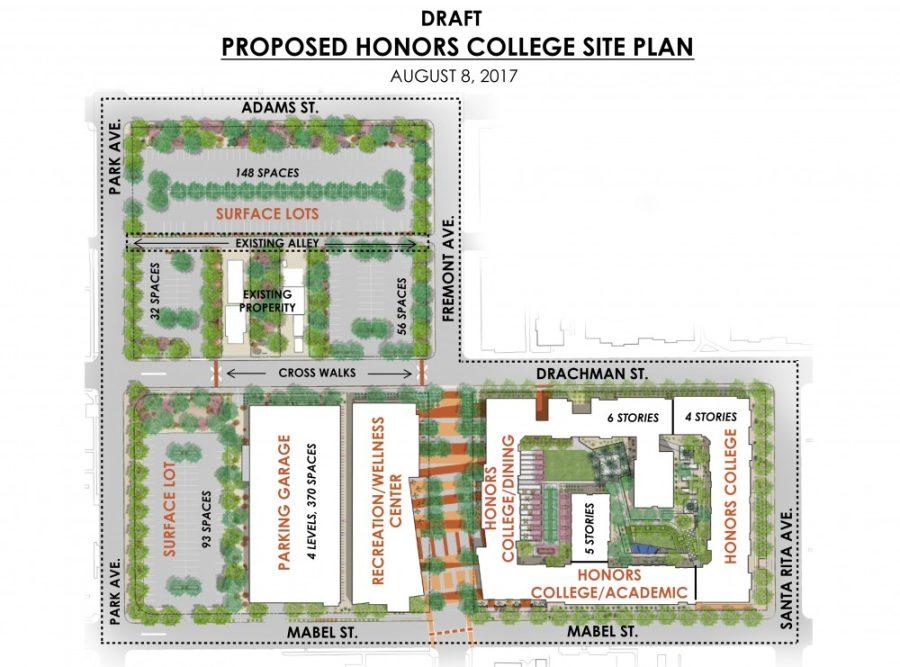The University of Arizona and the City of Tucson continue to negotiate the terms of the proposed Honors College Community project north of the UA campus.
At a City Council study session on September 19, the council voted to approve UA’s request that the city vacate and transfer city-owned Fremont Avenue between Mabel and Drachman streets. This was done so that the street could be incorporated into the Honors College Community in the event that the land does become state property and is not subject to city zoning.
“It allows us to go forward with the idea that we’re designing the street to be closed,” said Peter Dourlein, assistant vice president for Planning, Design & Construction and Campus Architect for the UA.
After studies performed by the UA, traffic and drainage concerns were raised about the area. Under the project’s developmental umbrella, this segment of Fremont would be closed to non-emergency vehicles and used for pedestrian and bicycle access in an effort to mitigate these concerns.
The city approved UA’s request under the condition that the approval satisfies conditions pertaining to the development impact and university’s ultimate management and ownership of the project.
“If we include conditions within an agreement that [the city is] a party to, then we have an enforcement mechanism to ensure that those conditions are actually carried out,” said City Attorney Mike Rankin. “This gives us an opportunity to actually have a contract.”
By doing this, the city has room to negotiate the terms of the complex in the future.
“It’s still open, so we’re still at the table in terms of discussing conditions we want to see crafted into this,” said Steve Kozachik, Tucson City Councilman for Ward 6.
Once completed, this facility, occupying three city blocks just north of campus at the intersection of Fremont Avenue and Drachman Street, will house more than 1,000 students, as well as a new recreation center, dining area, academic space and nearly 700 new parking spaces, essentially creating a mini-campus north of the UA.
Back in 2009, the private developer American Campus Communities starting buying up the land this project now sits on. Since then, ACC has acquired an entire city block and half of an adjoining one, with the intent of developing dorms on its property.
Highlighted in UA’s 2009 Comprehensive Campus Plan, the last available plan available from the university, only one block is mentioned as being a potential site of a university partnership for housing “at a scale appropriate to the surrounding neighborhood” and mentions that this use of the land “reflects desires by the community for new housing solutions.”
In the residential neighborhood where the proposed site is located, developers like ACC are required to adhere to city zoning ordinance because they are a private company.
The zoning would require them to limit the size and height of the project, among other things, to keep it consistent with the scale and character of the surrounding neighborhood.
RELATED: Neighbors conflicted over new honors complex
In 2013, ACC pitched a plan to build dorms in the neighborhood, but community members were shocked to see the proposal, which included larger buildings than neighbors expected and fell close to homes, and outside the campus planning boundry.
“They met with several of the surrounding neighborhood associations and presented the honors college essentially as it is now,” said Diana Lett, president of Feldmans Neighborhood Association.
Lett, who has been active in campus community relations for nearly 20 years, said that all three neighborhood associations approached by ACC were opposed to the six-story project being built in a neighborhood of one- and two-story residences.
Lett said a project that massive would be out of character for the surrounding residential area.
“They said they were going to pursue a rezoning because [ACC is] private,” she said. “At the time, there was no thought of the university acquiring the land.”
ACC’s 2013 proposal never made it off the ground, and the company quietly sat on the property for the next few years. That neighborhood opposition led to ACC exploring other ways to complete its project without rezoning.
“When [ACC] first brought the proposal forward, for a student dorm, the neighborhoods said they would push back and resist the rezoning, and as a result of that, ACC decided they would try and find the path of least resistance, and they did that by making an end-run around the rezoning process,” Kozachik said.
In March of this year, it was announced that the UA and ACC would be partnering to build the new honors complex.
According to Kozachik, ACC decided it didn’t want to go through the rezoning process. Instead, he said, ACC officials approached the university about making the land state property through a land acquisition by the Arizona Board of Regents and expanding the project onto the nearby property owned by the regents.
If it becomes state property, the project will not be subject to city zoning laws, property taxes or impact fees.

“The UA is building outside of their planning boundary, they’re building in a way that takes the community’s voice out of the process and they’re building in a way that is in violation of the clear language of [the Comprehensive Campus Plan], which says that if the UA goes outside of the planning boundary, they will abide by city zoning,” Kozachik said.
For a private developer like ACC to construct a project of this size, it would normally have to go through a public process to get rezoned, which could take a year, or potentially be stopped completely.
Instead of trying to move through that process, ACC made a deal with the UA.
“The only reason the UA is involved in this from a land ownership standpoint is to avoid the rezoning process,” Kozachik said.
By making a deal with the regents to transfer the land, ACC would be able to begin developing much sooner.
According to regent Chairman Bill Ridenour, this is also beneficial to the UA. The regents and UA officials want to get this project completed as soon as possible because they say it will help keep the university competitive with other institutions.
“We have a timing problem,” Ridenour said. “You submit those to zoning … [and] how long will that hold us up? We can’t answer those questions.
“We need to get started on this,” he added. “This is extremely important to the University of Arizona, so that the university is able to compete with all other schools.”
Kozachik said he has no qualms about the project itself, but he does fear that this process will hurt the credibility of the UA and hopes the project will go through the slower city rezoning process.
“The honors project itself is a wonderful idea, wonderful project. It’s the location and the manner in which it’s being done that is causing concern,” Kozachik said.
Many of the neighborhood representatives who have tried to be involved as this project has changed and grown are worried this could become a normal course of action when it benefits the UA.
RELATED: New honors college dean aims to bring program to new heights
“The university has a way of getting what they want,” said Grace Rich, president of the North University Neighborhood Association. “And little guys in the way … if they can do it, they’ll probably do something about the little guy.”
Kozachik said this could potentially open the floodgates to similar projects.
“This template would set a precedent for other developers to come in and start doing it, and the fact that it is outside of the university planning boundary means that if the UA moved forward with this model it could happen anywhere in the city; it doesn’t have to be right around campus,” Kozachik said.
Yet, Ridenour said this is a one-and-done deal and doesn’t expect the UA to use this method repeatedly.
“Every project stands alone, and so there would be no trend that the University of Arizona is going to do this in the future,” Ridenour said.
However, this process is lucrative for the UA for a variety of reasons, and Lett sees nothing that would stop the UA from using this method again.
“Various university representatives have said this is a one-off and that they’re not going to do this type of project again, this is not the type of public-private partnership that they want to use elsewhere,” Lett said. “City Council doesn’t believe that, and neither do I.”
Kozachik agreed.
“So from the UA’s perspective, they would obviously do that 10-times-out-of-10 if it weren’t for the fact that the process … does not involve any kind of public voice in the rezoning,” he said.
According to Kozachik, this process has never been used before in Tucson.
“This is the first time it’s been done here where a private developer has come in and simply given the university property,” Kozachik said. “This is a very novel, creative way of getting around the city zoning, and people looked at it and said ‘What the hell!’”
Looking forward, Lett said private litigation is a possibility but would be expensive to pursue, and what’s more likely is litigation from the city over property taxes.
“The only thing that will remain dealt with in court, by the time it finally gets there, will be the issue of whether this is a development that owes the city revenue,” Lett said.
Follow Daily Wildcat on Twitter.









